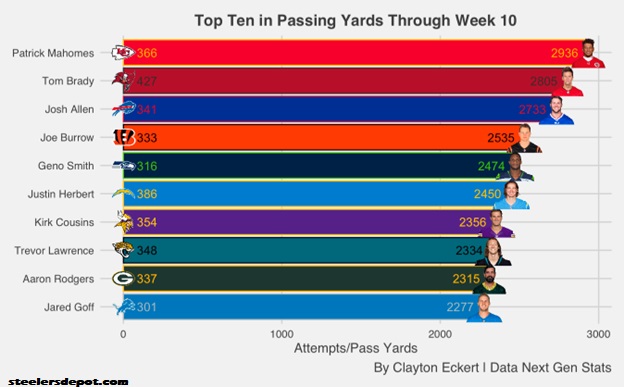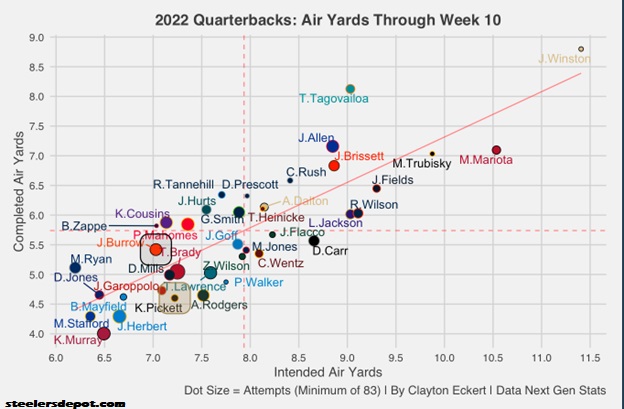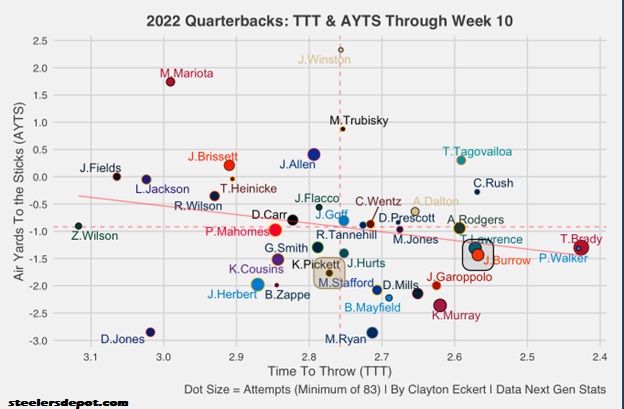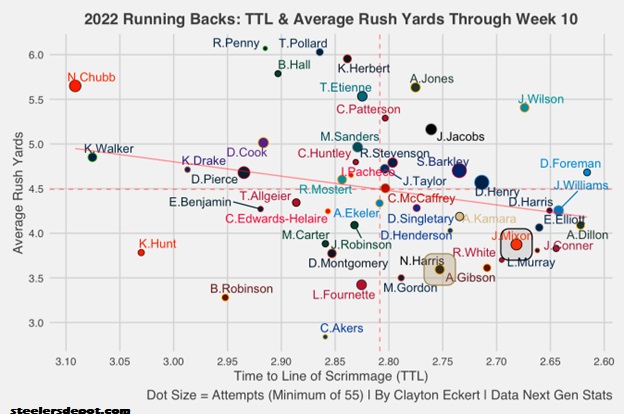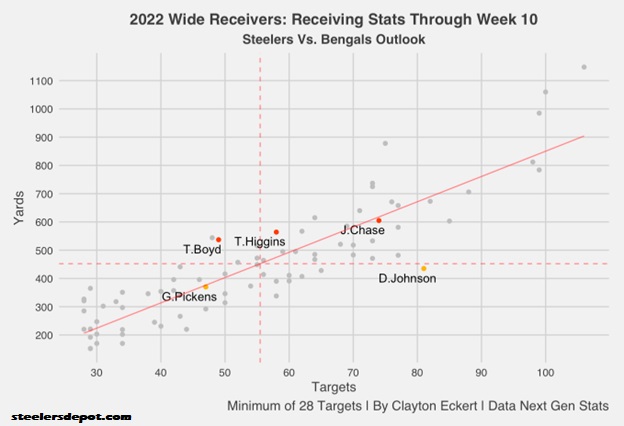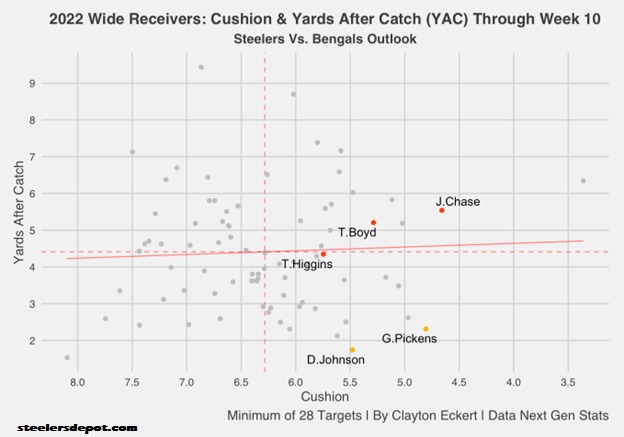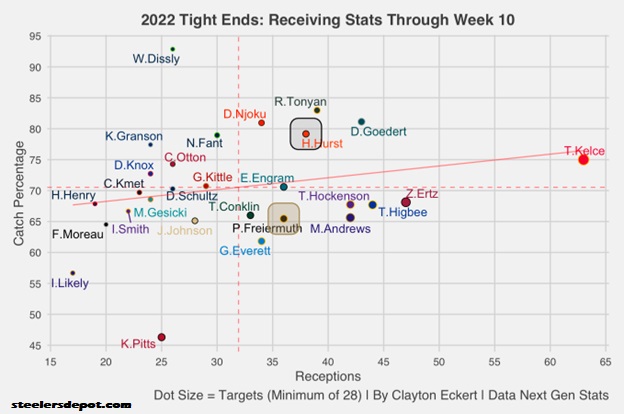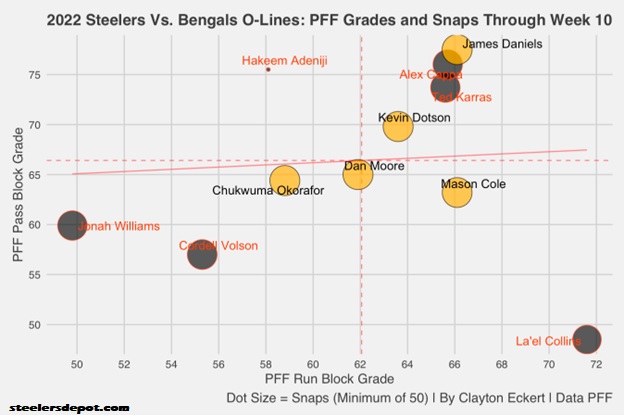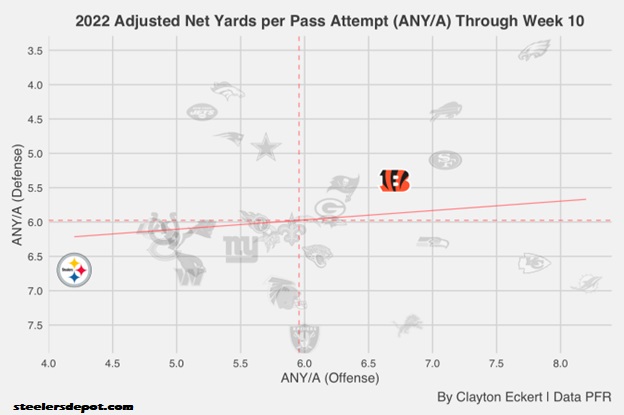The 3-6 Pittsburgh Steelers are coming off an encouraging win, and looking to carry things over the good team effort against strong divisional opponent in the Cincinnati Bengals, who are 5-4 and coming off a bye week. They present many challenges as I pointed out in my DIVISIONAL OUTLOOK and will dive into more in today’s article.
Let’s get into the matchup, starting with the quarterbacks, and here are the passing leaders through week ten:
Bengals quarterback Joe Burrow is having another strong season, currently fourth in the NFL in yards (2,535) on 333 attempts (ninth). The visual highlights the lower number of attempts than several other top passers to accomplish this feat, emphasizing the explosive Bengals attack coming back to earth a bit compared to their 2021 campaign, getting the ball in his playmakers hands and they have not disappointed (more on this to come). The name of the game has been quality with the fourth rank in completion percentage (70%), fifth in passer rating (102.6), tied for third in touchdowns (18), and fourth in TD/INT ratio (18/6). The latter is even more impressive when you consider four of his interceptions came in the opener against Pittsburgh, highlighting his extreme care of the football since. The defense will no doubt have to step up again in hopes of victory against the tough challenge Burrow and company present.
Steelers quarterback Kenny Pickett now has five starts, with 195 attempts for 1161 yards. He trended down in completion percentage to 11th (66.7%) following his lowest rate last week, and still bottoms the league in passer rating (68.8) and TD/INT ratio (2/8). He encouragingly did not turn the football over last week though, but needs to trend upward to put more points on the board and finish drives moving forward. Hopefully this starts on Sunday to maximize the continuation of quality defensive play that largely got them the victory in the season opener.
For more context on the quarterbacks’ passes, let’s look at intended and completed air yards on the season:
Both quarterbacks land below the mean in each data point, which further illustrates the earlier point on Burrow, whose 7.03 intended air yards ranks 33rd out of the 39 qualifying quarterbacks and are less than Pickett (7.22, 28th) on average. The completed air yards spotlight the difference in quality of the two on the season thus far, with Burrow’s 5.42 completed air yards ranking 23rd for an air yards differential that ranks ninth, compared to Pickett’s 4.6 completed air yards number that ranks 36th (fourth lowest) and an air yards differential that is tenth least in the NFL. Here’s to hoping the downfield connection can improve the season progresses, a major area he needs to improve as highlighted in my Passing Locations articles.
Last thing for the position, I wanted to look at time to throw numbers and air yards to the sticks through week ten:
Here we can see Burrow has the third fastest time to throw number in the NFL and a below the mean 28th AYTS, with the former highlighting the need for Pittsburgh’s defense to get pressure in the passing game quickly. They were up for said challenge in the season opener, sacking Burrow seven times which is the most he’s been dropped a game this season, and is the second most sacked quarterback so far in 2022. He had his second longest TTT on the season in the first matchup though, so it will be interesting to see what this looks like in the game considering his much quicker release time since week four. Big factor in the game that hopefully plays in Pittsburgh’s favor, including the corners perhaps needing to play a bit tighter and tackling the catch in front of them on the back end.
Pickett’s TTT is just below the mean and ranks 23rd, highlighting a big difference in the quarterbacks. With Pickett’s larger TTT number, you would ideally like more air yards (and connection) on average. His AYTS is 30th (tenth least) in the NFL, emphasizing his below average marks pushing the football down the field. While Pickett’s scramble and extend ability is positive at times, with more rush touchdowns than through the air (3/2), it has gotten him into trouble too often and would really like to see him be more decisive and get the ball out quickly a bit more, with hopefully more depth to varied route concepts that we saw more of last week.
Now for the running backs starting with rushing leaders through week ten:
Bengals running back Joe Mixon presents another stiff challenge for the Steelers defense, and is sixth in attempts (151) and 17th in yards (585) out of 49 qualifying players, which are both well above league average. One strong facet to his game is getting in the end zone (six touchdowns) with four of them coming against Carolina last week and ties for sixth most to on the season, compared to Steelers running back Najee Harris only having one. Mixon has punched several of his opportunities in from the red zone, and his longest run of the season came against the Steelers, busting through a big hole on a fourth and one conversion for a 31-yard gain where Pittsburgh safety Minkah Fitzpatrick made the touchdown saving tackle.
Fitzpatrick amazingly does not have an injury designation following an emergency surgery, huge positive news for Pittsburgh considering his team leading 11 tackle performance, who also have a clean injury report for this time of year (cornerback Ahkello Witherspoon the only player ruled out). The Steelers limited Mixon overall though, with only 82 rush yards and kept him out of the end zone, and here’s to hoping their stellar performance limiting a strong Saints rushing attack to only 29 yards continues, as Dave Bryan highlighted well in his Thursday Terrible Take.
Harris and the Pittsburgh run game are coming off their best performance to date, a breath of fresh air considering the subpar season overall. Harris had his best results on the season with 99 rush yards, 20 attempts, and five yards per carry with the team never trailing, improving his season averages to 15th in attempts (128) and 23rd in yards (460) which is now near the mean. Fingers crossed they can have another strong game as well, and seems overdue to punch one in the endzone with his only rushing score coming in week three.
In terms of receiving, Mixon is a huge threat and is fifth in the NFL with 272 yards, 38 receptions, and 45 targets, along with two touchdowns. They are very good in the screen game, with an example coming last week on his longest 35-yard catch of the season which also came against the Panthers. Harris has 29 targets, 24 receptions, and 112 yards for an outlook low 4.7 yards per reception, along with two short yardage touchdowns nearly connected on a long wheel in the red zone that would have been a huge boost to the offense, and obviously his yardage which is actually fourth in the outlook. Fingers crossed he gets another similar look in this game.
Steelers running back Jaylen Warren has really impressed this season, taking some of the load off Harris and is third in the matchup in carries (38), yards (190), and is second in the outlook with five yards per attempt. He has also fared well as a receiver, including a great showing last week where he provided an explosive 26-yard catch (with 25 in YAC). On the season, Warren is fourth in the outlook in targets (17), receptions (15), third in yards (128), and tops the group with 8.5 yards per reception, and here’s to hoping the committee approach continues with similar success. Cincinnati running back Semaje Perine is fourth in the matchup in carries (25), rush yards (133), and tops the group with 5.3 yards per attempt. He has also provided value as a receiver, third in the outlook in targets (21), receptions (18), yards (126), and yards per reception (seven), along with a touchdown.
Next let’s look at Next Gen’s efficiency metric, which measures north and south runners, and here are the ten least efficient on the season thus far:
Both lead backs land in the top ten with Harris at seventh least, which highlights some of the dancing around we’ve witnessed this season. He played much more to his strengths last game in a more north/south fashion, with decisive runs that contributed to his best game on the ground, and his efficiency number ranking seventh best in week 10. Hopefully this sticks for a continued positive trend as the engine to a more successful offense moving forward.
Mixon is currently tenth on average, and he similarly had his best game in this regard in his last opportunity with the third best number and his best results by far on 153 yards and four rushing touchdowns. Strong correlation for the two backs to say the least, and hopefully Pittsburgh’s defense can provide another strong outing in terms of missed tackles, coming off a record low of only two on defense since our own Josh Carney has provided his excellent missed tackles reports, along with 11 forced misses on offense.
Last thing for the position, I wanted to add context to the efficiency numbers with time to the line of scrimmage and average rush yards:
We can see both backs are above the mean in TTL but below league average in average rush yards. Mixon is currently the ninth in quickest to the line, so most of his work sideline-to-sideline has come in attempts to get extra yards beyond the line of scrimmage. Harris is also fairly quick to the line in comparison to the league (16th). Looking at their average rush yards, Mixon is tied for the 13th lowest average rush yards (3.9), while Harris is tied for 6th least (3.6), and whichever back can keep their upward trend from last game likely getting the win.
Let’s move to the wide receivers where Cincinnati rosters one of the best trios in the league. Bengals wide receiver Ja’Marr Chase has been ruled out for the matchup, and while I never wish injury on anyone, hopefully Pittsburgh can capitalize. Let’s look at the receiving stats through week 10:
All three Bengals wide receivers above the mean in yards (all 500+, none for Pittsburgh), highlighting the playmaking mentioned earlier. Chase is 15th (of 81 qualifying players) in targets (74) and yards (605), along with six touchdowns, which ties for third most in only seven games this season. He has moved around the formation the most, with 72.5% out wide and 26.4% in the slot. Cincinnati wide receiver Tee Higgins has 58 targets (T-35th), 564 yards (20th), along with four touchdowns. He has also moved around the formation quite a bit (77.2% wide, 22.5%) slot on the season, and played his most slot snaps last week (31.3%) after similar alignments to his season averages in Chase’s two missed games, so it will be interesting to see what this looks like Sunday and how the Steelers secondary fares. Fellow wide receiver Tyler Boyd has 49 targets for 537 yards (22nd), and three touchdowns, and has done most of his damage from the slot (81.8%). Cincinnati wide receiver Mike Thomas has played in all nine games this season, but targeted only eight times, which is actually fifth in the outlook but only two receptions (25% catch rate).
Steelers wide receiver Diontae Johnson is now ninth in the NFL in targets (81), but a much lower 39th in yards (435), but STILL has no touchdowns. This continues to highlight the scoring issues mentioned earlier, as I have been for several weeks, really rooting for Johnson to finally get one and put this unfathomable storyline to bed given his high usage. He and Pickett were able to connect on a nice explosive play on a go down the sideline last game, another element that would be great to see along with the encouraging route combinations that included fellow wide receiver George Pickens, who now has 47 targets for 370 yards and one receiving touchdown, and also added a nice rushing touchdown last week near the goal line. So, Boyd’s three receiving touchdowns (least of their top three) eclipses Johnson and Pickens combined.
Wanted to look at the slot numbers last game in the first game without wide receiver Chase Claypool, and tight end Pat Freiermuth actually had the most snaps (14) which was encouraging and something I had hoped for, followed by wide receivers Steven Sims (13) and Gunner Olszewski (12), along with Pickens getting eight snaps compared to Johnson’s five. Overall, Sims now has five targets and three receptions on the year, catching one of his two screen targets last week that went for a nice 15-yard gain. Hope to see this continue along with possibly building on it this week.
Another telling element for the matchup is the connection from the quarterback to the receivers, so let’s look at receptions and catch percentages:
The Bengals three receivers are in the top 35 in receptions, with Johnson tying with Chase at 15th (47). Boyd and Higgins have had very reliable hands on their 41 and 37 catches respectively, particularly the former who has the ninth ranked catch percentage in the NFL at 75.5%. Higgins is also above 70 percent (70.7) which is 24th in the league. Chase is top 20 in many Next Gen data points except his 63.5 catch percentage (40th), but is still third in the outlook, another area that each Cincinnati receiver best the Steelers. Pickens has 29 receptions and is fourth in the outlook in catch percentage (61.7), followed by Johnson’s 58%, and here’s to hoping Pickett can continue to find them more consistently and build on their rates that enjoyed an uptick last game considering Burrow’s strong receiver connection.
I also wanted to look at and provide YAC and cushion numbers:
All receivers in the outlook are in the top 20 in least amount of cushion, highlighting their more pressured situations to get open/make plays. The Bengals have capitalized the most with Chase and Boyd, each providing over five yards after catch on average! This highlights again how good Chase is (second least cushion and 19th in YAC) and how much they’ll miss him, but Higgins (5.2 YAC) and Boyd (4.3) are still a handful, with the latter’s above four yards as well and right at average for the NFL. They will hit you with the big play as well, with Chase and Boyd each having triple explosive catches of 60 yards to their name, and Higgins virtually the same with a 59 yarder, with each of those ending up in the end zone and included YAC.
Johnson has the second least YAC (1.74) in the league on the 11th least amount of cushion. He did have some good moments such as positive yardage of a slant, but also had a catch past the sticks but ran three yards backwards trying to make something happen, ultimately negating the would-be chain mover that brought his already low season average down. Pickens has the fifth least YAC (2.3) and third least cushion, with the former improving from his previous average thanks to a slant as well, along with ducking a tackle for tough YAC on a comeback route. Johnson and Pickens’ longest receptions are each 36 yards on the season, with neither having much YAC though great catches, particularly the latter on the insane one-handed extension catch earlier in the year. Here’s to hoping both improve on Sunday.
Next, let’s look at the tight ends, beginning with the receiving stats leaders:
Freiermuth is now tied for sixth in the league in targets (55), seventh in yards (403) out of 28 players on the graph, but only one touchdown from quarterback Mitch Trubisky earlier this season. We have seen many encouraging things from Freiermuth this season, but perhaps the biggest thing I’m hoping for is that he and Pickett can build a rapport in the red zone, and encouraging to hear Pickett say as much earlier in the week. Bengals tight end Hayden Hurst is 12th in targets (48), 16th in yards with 303 which is exactly 100 less than Freiermuth, and one touchdown this season. This came on a great red zone effort getting open on a post route with the YAC and diving extension to just get past the goal line.
Now for receptions and catch percentages:
This highlights another area where the Burrow connection wins out, with Hurst above the league mean in both, having the fifth ranked catch percentage (79.2) in the NFL on his 38 receptions which ranks eighth. Freiermuth has a 65.5 catch rate (23rd) and 36 catches (T-ninth) highlighting his below average connection that has to improve with Pickett overall moving forward, who needs to maximize his reliable hands. A prime example was on an over the middle one-handed catch last week, and hopefully this comes to fruition in the coming weeks, particularly in the red area.
Last for the position, here are separation and YAC numbers in 2022 thus far:
While both primary tight ends in the matchup are both below the mean in YAC, Hurst separates himself (pun intended) at the second highest rate so far this season, compared to Freiermuth at 25th (fourth least). Here’s to hoping we continue to see more routes as we did last game with him on the move, hopefully continuing to see over and crossing routes with more success as we saw last game. Freiermuth has the edge with 4.2 yards of YAC, which is also nearly two yards more than the Steelers wide receivers, compared to Hurst at 3.5 which rank 19th and 25th. Knock on wood Freiermuth can continue this on Sunday.
The offensive lines are always key to any matchup, and let’s see how the two teams have fared thus far with PFF grades:
Neither offensive line has played particularly well in 2022, with no individual grade topping 80. Pittsburgh did fare much better on the ground last week, which of course starts up front, and big key that hopefully continues, along with needing to keep Pickett clean against a stout Cincinnati defense. Steelers guard James Daniels tops the outlook in pass block grade (77.5) along with a 66.1 run block grade that is third in the outlook. Fellow guard Kevin Dotson is the only other lineman for Pittsburgh that is above the mean in both for the matchup (69.8 pass block, 63.6 run block) but each rank fifth and sixth in the outlook, which says a lot about the below the line play for the units of both teams this season, with Dotson’s lack of consistency and frustrating moments highlighted recently by our own Alex Kozora.
The remaining Steelers all land below the mean as pass blockers, a downward trend compared to a strong start earlier in the year. Center Mason Cole is tied for the best run block grade on the team (66.1) which is second in the outlook. Hopefully the team can keep their positive trend on the ground this week. Tackle Dan Moore is right at the mean in both in the outlook, with a 65 pass block grade and 61.9 as a run blocker. Fellow tackle Chukwuma Okorafor has struggled recently as the grades suggest, and is below the mean in both for the matchup, with a 64.4 pass block and the lowest 58.8 run block grade on the team.
Cincinnati revamped their offensive line this season, and two of their free agent additions land above the mean in both data points. Right guard Alex Cappa has the best-balanced grades for the team, with a 76 as a pass blocker (tops the team and second in the outlook) along with a 65.7 run block grade. Center Ted Karras lands similarly according to PFF, with a 73.7 pass block and 65.6 run block grade, and is the only offensive lineman in the matchup to make ESPN’s weekly win rates, ranking seventh as a run blocker suggesting his grade may be a bit low. Right tackle La’el Collins is also new to the team this season, and tops the outlook comfortably as a run blocker (71.6), but also bottoms the chart in pass blocking (48.5!). This presents a very appealing matchup for Steelers edge rusher T.J. Watt, and hopefully he can dominate and keep Burrow out of his element in the pass game.
The rest of their starters land below the mean in both, starting with rookie left guard Cordell Volson, who has a 57 pass block grade and 55.3 run block grade. Hoping and expecting the defensive line, particularly Cameron Heyward and Larry Ogunjobi to win inside, and the latters’ quick penetrating style hopefully showing up. Ogunjobi also ranks eighth in the ESPN run stop win rates this week, which could play a big factor against his former team in hopes of limiting Mixon. Left tackle Jonah Williams is the only returning starting lineman from 2021 for Cincinnati but has struggled as well, currently with a 59.9 pass block and 49.8 run block grade. Cue Steelers edge rusher Alex Highsmith, who is coming off a defensive player of the week performance and had three sacks in the last matchup. We can definitely see why Burrow is getting it out so quickly, and so eager to see how it all plays out on Sunday.
Looking at team stats, I wanted to provide the all-important singular stat in our opinion at Steelers Depot, Adjusted Net Yards per Passing Attempt ANY/A for offenses and defenses:
The Bengals are one of six teams that land above the mean on both sides of the ball, with a 6.7 number on offense and a 5.4 on defense that each rank very respectably at eighth in the NFL, and a quality 1.3 differential which ties for fourth best in the league. This highlights their strong situational play on both sides of the ball and the tough challenge Pittsburgh faces on Sunday. The Steelers have struggled mightily, with a 4.2 number that ranks dead last in the NFL by far, along with a 6.7 number on defense that ranks 26th for an abysmal -2.5 differential that is by far the worst in the league. Both numbers undoubtably need to improve the rest of the season, with the defensive number seeing the biggest improvement with Watt’s return, along with Pickett’s hopeful improvement in several areas mentioned earlier with more experience.
One of the main issues that has come up a lot is finishing drives in the red zone (and the ultimate goal of scoring), so I wanted to add context to the topic with red zone touchdown percentages for the league on both sides of the ball and takeaways for the matchup:
The Bengals are also above the mean on both sides of the ball again, with only five teams accomplishing this feat. They rank fourth on offense and are only one of four team with a rate of 70+ (72.4%) along with allowing only 53.8% on defense, which is just above the mean and ranks 12th. In comparison, the Steelers offense has a red zone touchdown percentage of 46.2% which ties for 28th, and obviously improving this is one of the most important keys to hopeful victory and positive trends moving forward. Pittsburgh’s defense has been able to tighten up on average in the red zone, at 50% which ranks an incredibly impressive sixth in the league sans Watt. His presence will likely limit the oppositions opportunities to get there in the first place, and here’s to hoping the team continues to provide and perhaps build on this rate moving forward.
Let’s look at the defenses from a player stats perspective to close, staring with Pittsburgh. Highsmith is fourth in the NFL with 8.5 sacks and also leads the teams with three forced fumbles, eight tackles for loss, and ten quarterback hits along with 36 combined tackles, and a pass deflection. Fitzpatrick is tied for third in the NFL with interceptions including one in the season opener on Burrow, and another for a pick six. He also has six passed defensed, 45 combined tackles, and a quarterback hit. Cornerback Cameron Sutton leads the team with eight passes defensed, two interceptions (one against Burrow last game), 23 combined tackles, and a tackle for loss. Linebacker Myles Jack leads the team comfortably with 72 combined tackles, along with two for a loss, one quarterback hit, and two passes defensed. Fellow linebacker Devin Bush is coming off a good performance, now second on the team with 47 combined tackles (surpassing Fitzpatrick on two less games), one tackle for loss and quarterback hit, and a pass defensed. Heyward has seven quarterback hits (T-second on the team), with the former also second in sacks (three) along with 34 combined tackles, five tackles for loss, a forced fumble, fumble recovery, and pass defensed. Ogunjobi is tied with Heyward in quarterback hits, along with 22 combined tackles, two tackles for loss, and half sack.
For Cincinnati, linebacker Germaine Pratt leads the team with 60 combined tackles, two for a loss, one sack and quarterback hit, four passes defensed, and an interception. Fellow linebacker Logan Wilson is second with 50 combined tackles, one for a loss, two quarterback hits, and two passes defensed including an interception. Very strong duo, which they also have the luxury of employing at the safety position, with Vonn Bell and Jessie Bates tying for third on the team with 40 combined tackles each. Bell also leads the team with four interceptions, has five passes defensed, four tackles for loss, two quarterback hits, a half sack and forced fumble, with Bates having three passes defensed and two interceptions. Edge rusher Trey Hendrickson leads the team with four sacks and 14 quarterback hits, along with three tackles for loss, two forced fumbles and passes defensed, and is also fourth in ESPN’s pass rush win rate as an edge defender. He’s strictly played on the right and he will be a huge challenge for Moore. Fellow edge rusher Sam Hubbard bookends the strong unit and leads the team with seven tackles for loss and second in sacks (3.5), quarterback hits (13), along with 38 combined tackles, three passes defensed, a forced fumble, and also made ESPN’s top ten with the seventh rank as a run stopper. Cornerback Chidobe Awuzie ties Bell for the team lead in passes defensed (five), along with 35 combined tackles, and a forced fumble. Very challenging divisional task for the Pittsburgh offense as they look to build off their win last week.
How do you think the game will play out on Sunday? Thanks for reading and let me know your thoughts in the comments!


